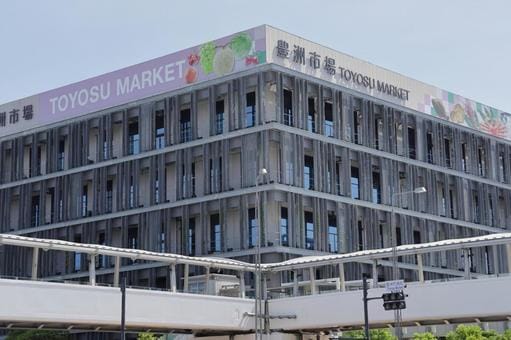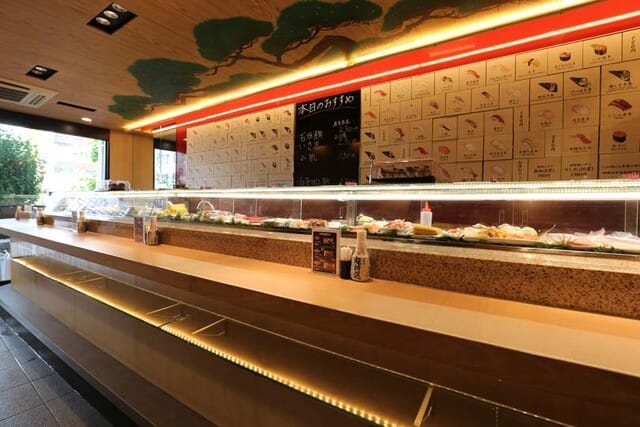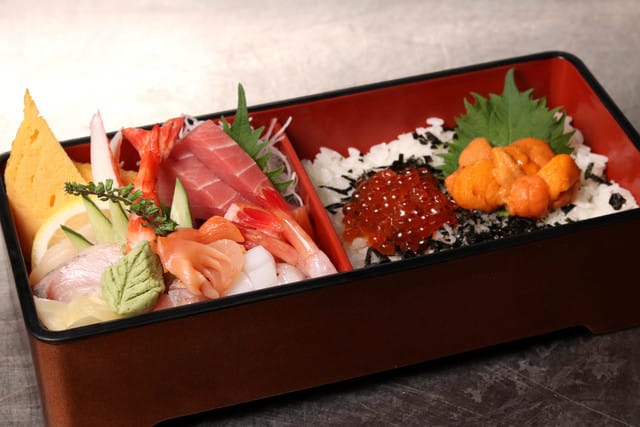Tokyo's Fish Markets: Enjoying the World's Largest Fish Culture
The reason for updating the article is the growing interest in tours that allow visitors to enjoy Japanese food culture and delicious dishes. As these tours gain popularity, Magical Trip's tour, which ranked #1 among all tours on Tripadvisor, has been receiving numerous applications.

For those interested in traditional Japanese cuisine especially Sushi, join the "Finest Quality Sushi & Tempura Dining Experience in Ginza," where a knowledgeable local guide will take you to their highly recommended Japanese restaurants. While enjoying sushi, tempura, and sake, your local guide will teach you proper dining etiquette and the best ways to savor each dish.
If you're interested in exploring the Tsukiji Market area, one of Japan's largest seafood markets located in Tokyo, consider joining the "Tsukiji Fish Market Walking Food Tour in Tokyo." You can enjoy food-hopping at the Tsukiji Outer Market and have a guide show you around the tourist attractions in the Tsukiji area.
We hope you'll have a wonderful time experiencing everything Sushi has to offer by joining a Magical Trip tour!
Introduction
Tokyo's fish markets are the epicenter of "fish culture," boasting a world-class scale. The vibrant market scenes with rows of fresh seafood never fail to captivate visitors.
I've lived in Tokyo for a long time, but I'm still thrilled by the atmosphere of the fish markets. It's like a fish theme park, with a unique vibrancy and energy. There, I can't help but feel the deep connection between Japanese people and fish.
In this article, I'll introduce the charms of Tokyo's two representative fish markets, Tsukiji Market and Toyosu Market, to foreign tourists. It's packed with information to fully enjoy the fish markets, from the history and highlights of each market to access methods, recommended dining spots, and tours.
During your stay in Tokyo, I encourage you to visit a fish market. I'm sure you'll feel the depth of Japanese food culture and the unique energy of the market firsthand.
Now, let's explore the world of Tokyo's fish markets together!
If you come to Tokyo and do not enjoy sushi in Ginza, where some of Japan's best restaurants are located, you will definitely regret it!
Please refer to the following article, which introduces a selection of the best sushi restaurants in the real “Japan” that you should try at least once while you are alive, and enjoy the best sushi in Tokyo.

Tokyo's Representative Fish Markets
First, I'll introduce you to the two representative fish markets in Tokyo: "Tsukiji" and "Toyosu."
Tsukiji Market

Tsukiji Market, established in 1935, was known as one of the world's largest fish markets. It functioned as the center of Tokyo's fish market for a long time but was relocated to Toyosu in 2018.
Even after the relocation, many restaurants and shops remain in the outer market of Tsukiji Market, maintaining its lively atmosphere.
I still love visiting the outer market of Tsukiji. I think the atmosphere of local shops crammed into the alleys is something that the new Toyosu Market doesn't have.
Toyosu Market

Toyosu Market took over the functions of Tsukiji Market in 2018 and now operates as Tokyo's central wholesale market. A modern market with state-of-the-art facilities was born on a vast site of about 40 hectares.
Compared to Tsukiji Market, Toyosu Market is characterized by a design that emphasizes hygiene management and efficiency. On the other hand, as it has become more tourist-oriented, I feel that the local charm that could be felt in Tsukiji has faded a bit.
Nevertheless, I like the scale of Toyosu Market and the unique atmosphere created by the latest facilities. I think the fresh sensation of experiencing a future fish market is also part of Toyosu Market's charm.
There Are Other Fish Markets in Tokyo

Actually, Tokyo has fish markets other than Tsukiji and Toyosu. There are unique markets scattered throughout the city, such as Adachi Market and Ota Market, which also handle vegetables.
These markets are characterized by being less touristy than Tsukiji or Toyosu. That's why you can experience a more locally rooted atmosphere. I sometimes visit these "hidden gem markets" to enjoy new discoveries and encounters.
I encourage tourists to search for "another fish market" in Tokyo too. I'm sure you'll find different charms of fish markets.
Highlights of Tsukiji Market
Next, I'll introduce in detail the charms of Tsukiji Market, one of Tokyo's representative fish markets.
Outer Market

The outer market of Tsukiji Market is an area that remains after the relocation of the main market, and it could be called the soul of the fish market. Narrow alleys are lined with delicious eateries such as sushi restaurants, seafood bowl shops, and tempura restaurants.
There are also many specialty shops selling marine products, dried foods, and kitchen knives, where you can enjoy market-specific shopping. Many shops in the outer market are open from early morning to afternoon, so it's bustling all day long.
The good access, just a few minutes' walk from Tsukiji Station, is also one of the charms of the outer market. When you visit Tsukiji, I recommend you experience the energy and deliciousness of the outer market.
Recommended Dining Spots in Tsukiji
Okame
Source: Tabelog by Kotaro
Okame is a standing sushi restaurant located right near Tsukiji Station. Its charm lies in being able to enjoy fresh Tsukiji-style fish at low prices in a super local atmosphere.
I once visited Okame with a friend. We stood at the narrow counter and enjoyed delicious sushi that was served one after another.
It's also nice that you can enjoy sushi at a reasonable price of 1,000-2,000 yen per person due to the standing style. I highly recommend this place for those who want to taste not only delicious food but also the local atmosphere.
However, it's only open on Fridays, Saturdays, and Sundays. Don't forget to check the business days before you go. No reservation is needed, so feel free to drop by.
<Store Information>
Address: 4 Chome-8-7 Tsukiji, Chuo City, Tokyo 104-0045
Closed: Mondays to Thursdays
Phone: Unavailable
Hours: 9:00 AM–5:00 PM
Website: Unavailable
Sushichou
Source: Tabelog by Sushichou
Sushichou is a popular standing sushi restaurant located a 1-minute walk from Tsukiji Station. Its charm lies in being able to enjoy fresh and delicious fish at a reasonable price, starting from 90 yen per piece.
When I go to Sushichou, I'm tempted to order various types of sushi. Everything is fresh and delicious.
But thanks to the reasonable pricing unique to standing sushi restaurants, I can enjoy a full sushi meal on a budget of 1,000-2,000 yen per person.
Even now that the market has moved to Toyosu, Sushichou is visited by both locals and tourists. That's how beloved this sushi restaurant is.
No reservation is needed, so please drop by during your Tsukiji stroll. I'm sure a delicious sushi encounter awaits you.
<Store Information>
Address: 3 Chome-10-9 Tsukiji, Chuo City, Tokyo 104-0045
Closed: None
Phone: 03-6226-5422
Hours: 11:15 AM–8:00 PM
Website: https://x.gd/wnYoe
Tsukiji Honganji Temple

Another attractive spot in this area, Tsukiji Honganji Temple, is a Jodo Shinshu temple rebuilt in 1934. Its distinctive Indian-style architecture, the beauty of the main hall and gardens captivate visitors.
When I visited Tsukiji Honganji Temple, I felt my heart being cleansed in a quiet space contrasting with the hustle and bustle of the market. I was impressed by the exotic atmosphere drifting within the appearance that evokes Japanese history.
Its location within walking distance from Tsukiji Market is also a pleasant point. I recommend you drop by along with your visit to Tsukiji Market.
Recommended Tours for Tsukiji Sightseeing
While tourists can visit Tsukiji on their own, I recommend using a tour to fully enjoy its local charm.
"Tsukiji Fish Market Walking Food Tour in Tokyo" by Magical Trip
Source: Magical Trip
For those who want to fully enjoy the Tsukiji area, I recommend our "Tsukiji Fish Market Walking Food Tour in Tokyo" by Magical Trip.
The charm of this tour is that you can fully experience the market atmosphere while visiting temples, shrines, and hidden famous shops in Tsukiji. Since it doesn't go to Toyosu, you can experience the traditional charm of Tsukiji to the fullest.
I recommend this tour for those who want to savor the history and food culture of Tsukiji over a 3-hour period.
Click here for more details: "Tsukiji Fish Market Walking Food Tour in Tokyo"
Highlights of Toyosu Market
Next, I'll introduce in detail Tokyo's new fish market, Toyosu Market, which relocated from Tsukiji.
Auction Viewing

One of the highlights of Toyosu Market is viewing the "auction" that takes place from early morning. The sight of various seafood, starting with tuna, being traded one after another with the auctioneer's calls is impressive.
I've also viewed the auction at Toyosu Market before. I headed to the market before dawn and waited for the moment the auction started. The sight of heated transactions starting all at once was truly a once-in-a-lifetime experience.
The auction takes place for about an hour from around 5:30 AM. When viewing, be aware that photography is prohibited in some areas.
I encourage you to experience the unique thrill of Toyosu Market by viewing the auction.
Fresh Fish Market

At Toyosu Market, not only can you view the auction, but the fresh fish market where fresh seafood is lined up is also a must-see. The array of fresh seafood selected by professional eyes is like a treasure box of the sea.
When I walk through the fresh fish market, I'm tempted to go shopping. It feels like a luxurious experience to select and purchase fish that was just landed that morning with your own eyes.
There are areas in the fresh fish market of Toyosu Market where general customers can make purchases, so please give it a try. It's open from early morning to afternoon, so I recommend dropping by casually between market tours.
Recommended Dining Spots in Toyosu
Yamazaki
Source: Tabelog by Yamazaki
When it comes to popular sushi restaurants in Toyosu Market, "Yamazaki" comes to mind. With over 40 years of history in Tsukiji, it continues to be popular even after relocating to Toyosu.
The charm of Yamazaki is, above all, the array of fresh and high-quality seafood. The ingredients selected from the market every morning are turned into exquisite sushi by the skill of the artisans.
The budget is set a bit high at around 3,000-4,000 yen per person, but in return, they have absolute confidence in their ingredients and taste. I hear that reservations are relatively easy to get two weeks in advance, so please consider it as a candidate when planning your meal at Toyosu Market.
<Store Information>
Address: 3F, Administrative Facility Building, 6 Chome−6−1 Toyosu, Koto City, Tokyo 135-0061
Closed: Wednesdays, Sundays
Phone: 03-6633-0215
Hours: 7:00 AM–1:30 PM
Website: http://www.sushi-yamazaki.com/
Daiwa Sushi
Source: Tabelog by Daiwa Sushi
When it comes to super popular restaurants in Toyosu Market, "Daiwa Sushi" is the one. Known as a famous sushi restaurant using high-quality tuna, it's crowded with many customers every day.
The interior of Daiwa Sushi is in the "orthodox sushi restaurant" style with only counter seats. The fresh sushi carefully prepared by the artisans right in front of you is exquisite. I think the tuna items like otoro and chutoro are especially delicious.
However, the popularity of Daiwa Sushi is also evident in the waiting time. There's already a long line at 6:00 AM when it opens, so I recommend going as early as possible. The budget is a bit high at 6,000-7,000 yen per person, but once you taste it, you'll understand why.
<Store Information>
Address: 6 Chome-3-2 Toyosu, Koto City, Tokyo 135-0061
Closed: Wednesdays, Sundays
Phone: 050-3144-0220
Hours: 6:00 AM–1:00 PM
Instagram: https://www.instagram.com/daiwazushi/
Recommended Tours for Toyosu Sightseeing
When sightseeing in Toyosu, using a tour can help you enjoy Tokyo's latest fish market more smoothly.
"Toyosu Inside Market Tour & Sushi Making Workshop" by True Japan Tour
Source: True Japan Tour
For those who want to fully enjoy the charm of Toyosu Market, I recommend the "Toyosu Inside Market Tour & Sushi Making Workshop" by True Japan Tour.
The biggest attraction of this tour is that it combines a tour of the market interior, which is usually not accessible, with a sushi-making experience. You can have the luxurious experience of procuring fresh ingredients in the market and then learning how to make sushi from professionals using those ingredients.
The tour content is packed, and you can make multiple types of sushi, from the most traditional nigiri sushi to the visually cute gunkan-maki.
However, the fee is quite high at about 46,000 yen per person, so it's a tour for those with a flexible budget. But it's a valuable opportunity to experience both the behind-the-scenes of Toyosu Market and sushi making at the same time. If you're interested, please consider participating.
Click here for more details: "Toyosu Inside Market Tour & Sushi Making Workshop"
How to Access the Fish Markets
I recommend using public transportation to access Tokyo's main fish markets.
- Tsukiji Market: 1-minute walk from Tsukiji Station on the Tokyo Metro Hibiya Line, 2-minute walk from Tsukijishijo Station on the Toei Oedo Line
- Toyosu Market: 5-minute walk from Toyosu Station on the Tokyo Metro Yurakucho Line, 1-minute walk from Shijomae Station on the Yurikamome Line
While access by bus or taxi is possible, the roads around the markets tend to be congested. For smooth arrival at the markets, using trains or the Yurikamome is wise.
Frequently Asked Questions About Tokyo's Fish Markets
Finally, I'll answer common questions from travelers about Tokyo's fish markets.
Do I Need a Reservation to Visit the Fish Markets?
No reservation is needed when visiting the markets individually. Toyosu Market has a dedicated viewing area called the "Observation Deck," but you need to make a reservation through a lottery system to use it. However, don't worry - you can freely visit the general areas within the market without using the Observation Deck.
Can I Take Photos Inside the Markets?
Basically, you can freely take photos in areas where photography is allowed. However, there are also areas where photography is prohibited, so be careful about that. Also, avoid taking photos while walking as it's dangerous. Make sure to follow the manners and not obstruct the work of market staff when taking photos.
Especially when photographing products or shops, it's good manners to get permission in advance. I always make sure to say a word to the shop owner before taking photos. By communicating, you can also get closer to the people at the market.
Can Foreign Languages Be Used in the Markets?
As many tourists visit the markets, simple communication in English is possible at major shops. However, you might still feel a language barrier. It's a good idea to have a translation app ready just in case.
Also, the guidance signs in the markets are well-equipped with foreign language notations including English, Chinese, and Korean. However, if you need more detailed explanations, it's more reliable to participate in guided tours that can accommodate foreign languages, like the ones I introduced in this article.
What Time Is Best to Visit the Markets?
I recommend choosing the time to visit the markets based on your purpose. If you want to watch the early morning auctions, aim to arrive around 5:30 AM.
On the other hand, if you want to enjoy meals or shopping, I recommend visiting around 10-11 AM. Be aware that many shops close early in line with the market's business hours.
What Are the Recommended Dishes to Eat at the Markets?
At Tokyo's fish markets, you can taste various dishes using fresh seafood. Among them, I especially recommend fresh sushi toppings like tuna, sea urchin, and salmon roe. A luxurious seafood bowl (kaisendon) loaded with extra-large shrimp, crab, and scallops is also recommended for those who want to feel full.
Tsukiji Market and Toyosu Market. These two representative fish markets in Tokyo are places that could be called "Tokyo's kitchen," where you can experience fresh seafood and unique market culture.
From watching early morning auctions to enjoying meals of fresh sushi and seafood bowls, and searching for souvenirs, Tokyo's fish markets are full of charms that never bore us, no matter how we spend our time there.
I hope you'll use this article as a reference and actually experience Tokyo's fish markets for yourself!










